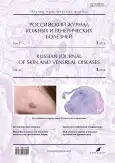B-cell lymphoma of the skin: clinical observation
- Authors: Karacheva Y.V.1, Smykova A.N.1
-
Affiliations:
- Professor V.F. Voino-Yasenetsky Krasnoyarsk State Medical University
- Issue: Vol 27, No 3 (2024)
- Pages: 241-248
- Section: DERMATO-ONCOLOGY
- URL: https://journals.rcsi.science/1560-9588/article/view/262712
- DOI: https://doi.org/10.17816/dv626353
- ID: 262712
Cite item
Abstract
Currently, there is an increase and an increase in the incidence of primary skin lymphomas worldwide. B-cell cutaneous lymphomas account for 25–30% of primary skin lymphomas. Among all skin lymphomas, primary cutaneous lymphoma from follicular center cells occurs in 10–11% of cases and is characterized by great diagnostic difficulties due to the great similarity of clinical manifestations with other dermatoses, such as benign lymphoplasia, Beck's sarcoidosis, Jessner–Kanof lymphocytic infiltration, skin metastases.
This paper presents a clinical case of B-cell lymphoma in a 29-year-old woman with a lesion of the facial skin in the form of a node, initially incorrectly interpreted as benign lymphoplasia. For five years, the patient received therapy with topical glucocorticosteroids with no effect from. Subsequently, histological examination and immunohistochemistry were performed for the purpose of differential diagnosis of sarcoidosis with B-cell lymphoma. Histologically, there is nodular proliferation of atypical lymphoid cells in the dermis, most of which have cytological characteristics of a centrocyte with an admixture of a small number of central blasts. Nodular proliferates contain an admixture of compactly arranged small lymphocytes. There are no signs of epidermotropism. During immunohistochemical examination, cells forming nodular proliferates express CD20, bc16 with an index of proliferative activity for the expression of nuclear protein K167 ― 20–30%, a dissociated network of follicular dentritic cells expressing CD21 is determined at the base of nodular proliferates. They are not expressed by bc12, CD3, CD2, CD5 proliferate cells. CD117 is expressed by an admixture of discretely distributed mast cells. The morphological picture corresponds to primary cutaneous centrofollicular lymphoma. The node was excised. Radiation therapy was not prescribed due to the patient's pregnancy.
This clinical observation highlights the importance of considering the diagnosis of lymphoma in the differential diagnosis of treatment-resistant dermatological diseases.
Full Text
##article.viewOnOriginalSite##About the authors
Yulia V. Karacheva
Professor V.F. Voino-Yasenetsky Krasnoyarsk State Medical University
Email: julkar19@yandex.ru
ORCID iD: 0000-0002-7025-6824
SPIN-code: 4789-9178
MD, Dr. Sci. (Med.), Associate Professor
Russian Federation, KrasnoyarskAnastasia N. Smykova
Professor V.F. Voino-Yasenetsky Krasnoyarsk State Medical University
Author for correspondence.
Email: smykova.a@mail.ru
ORCID iD: 0000-0001-5846-4244
SPIN-code: 2226-9685
MD, Cand. Sci. (Med.)
Russian Federation, KrasnoyarskReferences
- Kuklin IA, Kohan MM, Demidov SM. Primary lymphomas of the skin. Practitioner. 2018;(5):27–29. EDN: XQSAHR
- Eder J, Kern А, Moser J, et al. Frequency of primary cutaneous lymphoma variants in Austrаlia: Retrospective data from a dermatology referral centre between 2006 and 2013. Eur Acad Dermatol Venereol. 2015;29(8):1517–1523. doi: 10.1111/jdv.12907
- Blaizot R, Ouattara Е, Fauconneau A, et al. Infectious events and associated risk factors in mycosis fungoides/Sézary syndrome: A retrospective cohort study. Br J Dermatol. 2018;179(6):1322–1328. doi: 10.1111/bjd.17073
- Potekaev NN, Khamaganova IV, Almazova AA, et al. The problems of epidemiology, diagnosis, and organization of medical care for patients with cutaneous lymphomas. Russ J Clin Dermatol Venereol. 2013;11(4):4–7. EDN: RBMEGT
- Zhang X, Condon JR, Rumbold AR, et al. Estimating cancer incidence in Indigenous Australians. Aust NZ J Public Health. 2011;35(5):477–485. doi: 10.1111/j.1753-6405.2011.00762.x
- Bulanova NV, Semochkin SV. Difficulties in diagnosing ALK-negative anaplastic large cell lymphoma manifesting from a skin lesion. Russ J Skin Venereal Dis. 2022;25(6):25–32. EDN: DYLDIB doi: 10.17816/dv115012
- Denisjuk N, Kerl K, Cozzio A. Primary cutaneous B-cell lymphoma. J Deutschen Dermatologischen Gesellschaft. 2012;10(1):12–22; quiz 23. doi: 10.1111/j.1610-0387.2011.07852.x
- Lamotkin IA, Rukavitsyn AO, Gladko VV, et al. Skin B-cell lymphomas: 20 years experience in observation and treatment. Russ J Skin Venereal Dis. 2017;20(5):260–266. EDN: YLWZAS doi: 10.18821/1560-9588-2017-20-5-260-266
- Lamotkin IA. Oncodermatology. Atlas. Textbook. Moscow: Laboratoriya znanii; 2017. 878 р. (In Russ).
- Fingers MA, Potekaev NN, Kazantseva IA, et al. Clinical and morphological diagnosis of skin diseases (Atlas): Textbook. Moscow: Meditsina; 2004. 428 p. (In Russ).
- Lauren P. Diagnosis and management of cutaneous B-cell lymphoma. Dermatologic Clin. 2015;33(4):835–840. doi: 10.1016/j.det.2015.05.003
Supplementary files










